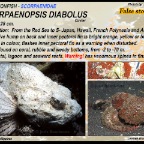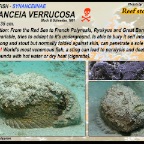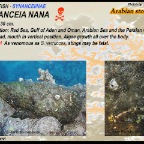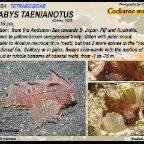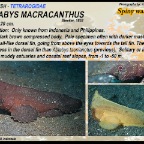Scorpionfish - Scorpaenidae
SCORPIONFISH - SCORPAENIDAE
This fish species has about ten sub-families from which the most common are of course the lionfish (Pteroinae) and the true scorpionfish (Scorpaenidae). There are also the stonefish (Synanceiinae), devilfish (Choridactylinae) and waspfish (Tetrarogidae). Most of them have a red-brownish color with a different pattern, depending on the species. Of all of the subfamily, it is only the lionfish that swim around to find prey and feed. All the others trust their camouflage and wait for hours till their prey passes and attack. By opening their mouth very quickly, they create a sucking movement and in about a fifteen millionths of a second, suck in their prey. Devilfish are the only species of the scorpionfish family that don't have pelvic fins. Because they live as bottom-dwellers, their pelvic fins changed into hook-shaped legs which they use for walking over the bottom. They often burry themselves into the substrate for camouflage (sand or rubble). Every scorpionfish species also has poisonous stingers. Injuries caused by these stingers cause severe pain and can lead to paralysis, or even death. Length: 23 cm.Distribution: from E- Africa to Caroline Isl., S- Japan and Mauritius.Compressed body and upturned snout, skin flaps and filaments.Variable in colour, from pink to brown or yellow colour. Possible mimic of crinoids. Mostly near bases of coral heads, down to -90 m. Rare! Length: 15 cm.Distribution: from Indonesia to S- Japan and NW- Australia.Similar to S. macrochir but head less steep and snout more humped. Variable in colour, from yellow to red. Lives solitary on sand and mud bottoms of seaward reefs to -40 m. Length: 15 cm.Distribution: from Mauritius to SW- Japan, Marquesas Is. and Australia.Similar to S. diabolus but smaller and shorter snout. Variable in colour, from grey to green and red. Inner side of pectoral fins bright yellow-orange with wide black border and small black spots on narrow part. Lives solitary or in pairs on sand, rubble, rocks or weed bottoms of coastal reefs to -80 m. Length: 28 cm.Distribution: from the Red Sea to S- Japan, Hawaii, French Polynesia and Australia.Distinctive hump on back and inner pectoral fin is bright orange, yellow or black.Variable in colour, flashes inner pectoral fin as a warning when disturbed.Can be found on coral, rubble and weedy bottoms, from -2 to -70 m. On coastal, lagoon and seaward reefs. Warning! has venomous spines in fins. Length: 19 cm.Distribution: from Mauritius towards Indonesia and Philippines.Very similar to R. frondosa which has numerous short skin flaps.Variable in colour, from yellow to orange, red, purple, pink or bluish.Walks over the substrate using it’s pectoral fins. Sand or weedy areas of seaward reefs, from -18 to -55 m. Length: 35 cm.Distribution: from the Red Sea to French Polynesia, Ryukyus and Great Barrier Reef.Colour variable, tries to addapt to it’s underground. Is able to bury it self into the sand. Spines long and stout but normally folded against skin, can penetrate a sole of a shoe.Warning! World’s most venomous fish, a sting can lead to paralysis and death.Treat wounds with hot water or dry heat (cigarette). Length: 18 cm.Distribution: from E- Africa to S- Japan, Papua New Guinea and Great Barrier Reef.Similar to S. oxycephalus but smaller, less colourfull and not so common.Lives between loose rocks on coastal reefs and lagoons.Warning! Has venomous spines, can lead to severe pain and paralysis. Length: 12 cm.Distribution: from Indonesia to S- Japan and N- Australia.Mostly red-brown but there are color variations of pink, green, dark brown and yellow.Long cirrus (extention) above the eyes, large wing-like pectoral fins. Mostly with manyskin flaps and filaments on head, body and fins, when in areas with filamentous algae. Lives solitary on sand, algae and mud bottoms, from -3 to -40 m. Length: 13 cm.Distribution: from S- India towards S- China, Philippines and New Caledonia.Specimens from Gulf of Thailand with large reddish-brown blotches, others have less solid markings. Mostly with white face and white spot above lateral line.Blotched pectoral fins. Solitary, silt and sand bottoms, among corals and often in weed beds to -70 m. Hunts on small crustaceans during night. Length: 22 cm.Distribution: Indonesia, New Guinea, Marshall Is, French Polynesia, SW- Japan, GBR.Very similar to the Tasseled scorpionfish except, the white vertical band from the eyesto the chin and the white band above the head. Lives solitary on seaward reefs to -40 m. Length: 9 cm.Distribution: only known from Indonesia and Philippines.Brownish face and upper body, orange-red cheeks, lower body and base of pectoral fin. Lowest ray of wing-like pectoral fins separated and used for walking. Fine white barbels on chin and white blotch on sides of the mouth.Lives solitary on sand bottoms of coastal waters, from -12 to -60 m. Length: 10 cm.Distribution: E- Africa to Galapagos, SW- Japan, Hawaii, Fiji and Great Barrier Reef.Compressed head and body, high and long dorsal fin. Very variable in colour, changesouter layer of skin every few weeks. Rocks from side to side to mimic a leaf or debris in the current. Can be found in lagoons or outer reefs among stones, weeds or sponges, down to -34 m. Solitary or in pairs. Feeds on small crustaceans and fishes. Length: 18 cm. Distribution:Thailand to SE- China, Philippines, Vanuatu, New Caledonia and Australia.Colour variable, from a pale sand colour to rust-brown, dark pink, red and black.Inner pectoral fins pale yellow, orange or pink and black. Often burried in sand up tothe eyes, walks on the bottom with pelvic fingers. Lives on sand or silt in lagoons andon seaward reefs, from -5 to -40 m. Ambushes small fishes and crustaceans. Length: 30 cm.Distribution: from India to China, Papua New Guinea and Great Barrier Reef.Bony ridge above and between the eyes, prominent raised warts on sides. Light to dark brown. Prefers coastal reefs including estuaries, Often partially buried in sand and rubble. Warning! As venomous as S. verrucosa, stings may be fatal. Length: 30 cm. Distribution: Red Sea, Gulf of Aden and Oman, Arabian Sea and the Persian Gulf.Wide head, mouth in vertical position. Algae growth all over the body.Warning! As venomous as S. verrucosa, stings may be fatal.Length: 15 cm.Distribution: from the Andaman Sea towards S- Japan, Fiji and Australia.Dark brown to yellow-brown compressed body. Often with paler snout. Very similar to Ablabys macracanthus (next), but has 2 more spines in the “more wavy” sail-like dorsal fin. Solitary or in pairs. Sways side-wards with the motion of the water. Sand, mud or rubble bottoms of coastal reefs, from -1 to -78 m. Length: 20 cm.Distribution: only known from Indonesia and Philippines.Pale to dark brown compressed body. Pale specimen often with darker mask. Pointy sail-like dorsal fin, going from above the eyes towards the tail fin. They have 2 spines less in the dorsal fin than Ablabys taenianotus (previous). Solitary or in pairs.Sand or muddy estuaries and coastal reef slopes, from -1 to -50 m.









